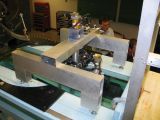Scientists from the US Air Force (USAF) Academy are currently working on a new method of making wave energy readily available for harvest. The technology will be able to exceed the current limitations that plague the industry, and could result in power plants that can better withstand the rigors of the sea, while at the same time capturing more energy more efficiently. Moreover, the innovation can theoretically be placed at any depth, and at any location in the ocean. It relies on technologies used to keep airplanes in the air, its manufacturers say.
Essentially, what the new harvesting method does is cancel incoming waves, in that it harvests their energy by flattening them out. This implies that the application could also be used as a type of energy-generating wave breaker for ports in the near future. The new design will be presented on November 24 in Minneapolis, Minnesota, at the 62nd annual meeting of the American Physical Society's Division of Fluid Dynamics. In the approach, the active elements are sensors and adjustable parts, which allow the fluid to flow around airfoils submerged in water-like air flows around wings.
“Our group was working on very basic research on feedback flow control for years. For an airplane, when you control that flow, you better control flight – for example, enabling you to land a plane on a shorter runway,” Stefan Siegel, the lead researcher on the new project, explains. Scale models and computer simulations have revealed that the work, even in its preliminary stages, is capable of harvesting more electricity from waves than the most efficient wind turbines can do from air flows.
“Every airplane flies with lift, not with drag. Compare an old style windmill with a modern one. The new style uses lift and is what made wind energy viable – and it doesn't get shredded in a storm like an old windmill. Fluid dynamics fixed the issue for windmills, and can do the same for wave energy,” Siegel adds. The design relies on cycloidal propellers, which is a technology developed in the 1930s that still powers tugboats, ferries, as well as a host of other maneuverable ships.
The propeller is oriented vertically rather than horizontally, which allows the new device to use a standard gear-driven or direct-drive generator to produce electrical energy. A larger model of the wave-energy device will be tested next year in the Oregon State University tsunami-wave basin, where the National Science Foundation's (NSF) Network for Earthquake Engineering Simulation (NEES) is located.

 14 DAY TRIAL //
14 DAY TRIAL // 
